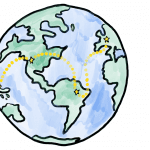The 4 essential elements to include in your team retreat – and the exact 3-day team retreat agenda we held for Know Your Team.
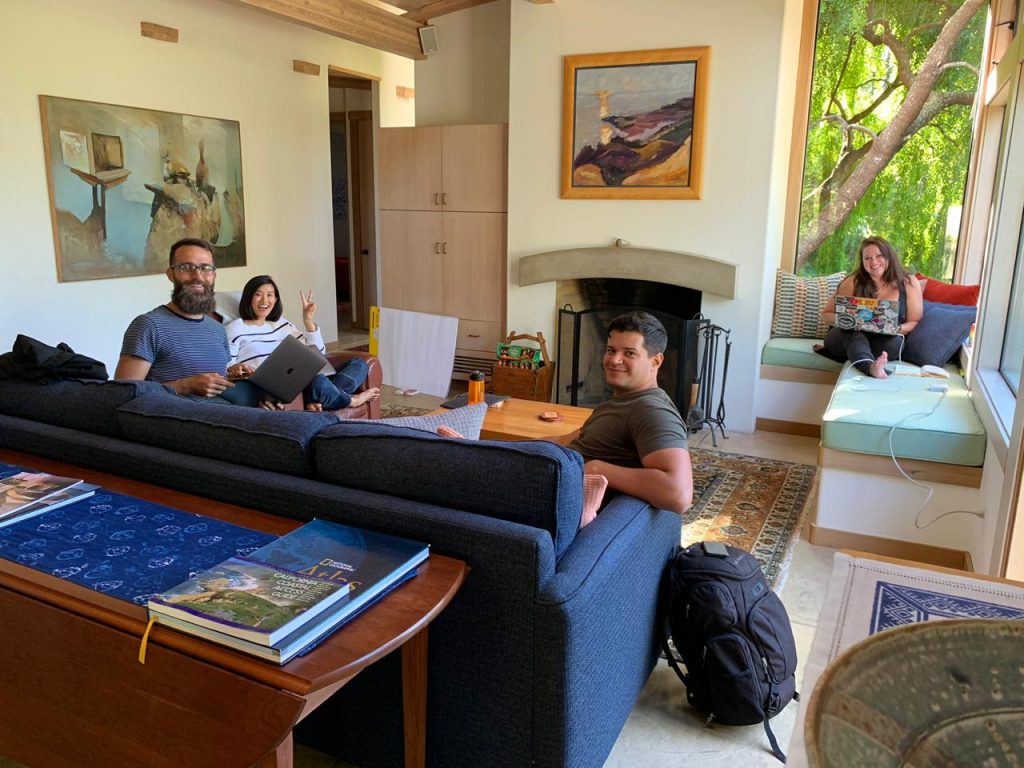
This was a first for us: We held a team retreat for Know Your Team. Though we’ve been in business for the past five years, we’d never had an official team retreat. Sure, we’ve had strategy sessions (my business partner Daniel and I hold these every month), and we’ve had fun team dinners and social outings over the years… But as a two-person company serving 15,000+ people, we’ve always felt too small to do a formal team-building retreat.
A team retreat is different. It’s dedicated time for everyone in the team as a whole to reflect on the business, get aligned, and chart a path forward. However, we recently doubled our company’s size – going from two people to four people (hilariously, that does indeed amount to 2X team growth 😂)… And so, Daniel and I decided it was finally time for a team retreat. Especially as a remote company, in-person time, becomes even more valuable. I thought a team retreat would be a helpful way to integrate our new hires into a remote team.
Though we’d never held a team retreat before, I luckily had the wisdom of 1,000+ managers in our online leadership community, The Watercooler, to draw from. From these conversations, as well as discussions with other CEOs and executives who are Know Your Team customers of ours, here’s how we went about planning and running a successful team retreat:
#1: Define success.

Mandy and Marcus, our two new hires, were flying in from Pennsylvania and Brazil, respectively. I didn’t want them to travel all that way, and for them to walk away feeling like what we could’ve accomplished with the team retreat could’ve been accomplished remotely. Or, even worse: To have them feel that not much had been accomplished at the retreat, at all. The retreat had to have utmost utility – or else, what was the point?
As a result, as part of the planning process, I wanted to be rigorous about making sure we were intentional about what “success” for the retreat really looked like. Based on the range of purposes for team retreats that our online community shared and our own specific needs as a company, here’s what I wanted everyone on the team to walk away with:
- Context and background. Everyone in the team should understand why we operate the way we do, how we think about decisions, and our frameworks for how we consider projects, execute on them and interact with one another.
- Alignment and clarity. Why does what we do matter? How does each person’s individual contribution roll up to the bigger picture of what we’re trying to accomplish? Where are trying to go, to begin with?
- Trust and rapport. A team doesn’t function well without a foundation of trust – that is, both affective trust (based on interpersonal relatedness) and cognitive trust (based on reliability and competence). For a remote team, in particular, an in-person retreat is a perfect opportunity to build both types of trust.
That’s what I envisioned as “success” for the retreat. But I also wanted to make sure that I was including each team member’s ideas of success as well.
As a result, at the beginning of the retreat, we took 15 minutes to brainstorm together what we all envisioned as success for the retreat. Here were their responses:
Success for the retreat is…
Understanding the vision
Understanding the product – what we’re doing today, what we’ll do in the future, and how to improve.
Getting all on the same page.
Knowing each other on a deeper level + what makes each of us tick.
You’ll notice there was almost an exact overlap between each team’s vision of success and what I originally laid out (fortunately!).
So how did we go about fulfilling the promise of success for each of these things we outlined? Read on.
#2: Share context.
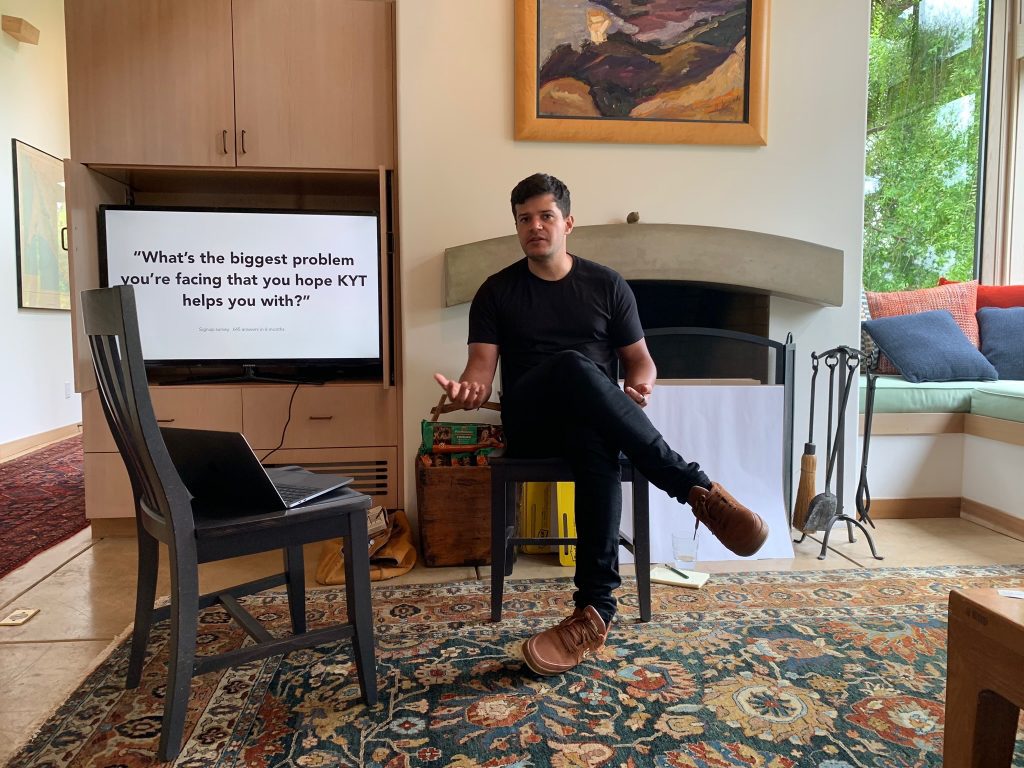
With Mandy and Marcus being new to Know Your Team, sharing the background for where we are, how we make decisions, and why, was critical. Without an understanding of our company history or the thought process behind some of the key decisions we’ve made, they wouldn’t understand, how to make decisions going forward. As Netflix famously espoused in its 2009 culture deck, a high context environment begets a low control environment. The more context Marcus and Mandy have about Know Your Team, the more they can decide for themselves what to do, rather than relying on us telling them what to do.
Specifically, here’s what our team needed to have context on, during the team retreat:
- Company history. What’s the company’s origin story? Key milestones? Reasons for certain decisions? To avoid having this devolve into a lecture of me rattling off company facts, I instead organized all the information as a light-hearted trivia game. It ended up being much more engaging than the former!
- Market opportunity. What’s the exact problem you’re solving? Who is our customer? Why? What are the market trends? Who are our competitors? Since we relaunched the company to have a new product, new pricing model, and company name just seven months ago, we spent a disproportionate amount of time diving deep into the problem and customers, themselves.
- Functional frameworks – How do we make decisions around our most important work functions? In our case, Product and Marketing are our two primary work functions. And so in order for the team to make well-informed decisions around both, Daniel and I spend a lot of time sharing our frameworks for how we think about making decisions around Product and Marketing.
#3: Create alignment.
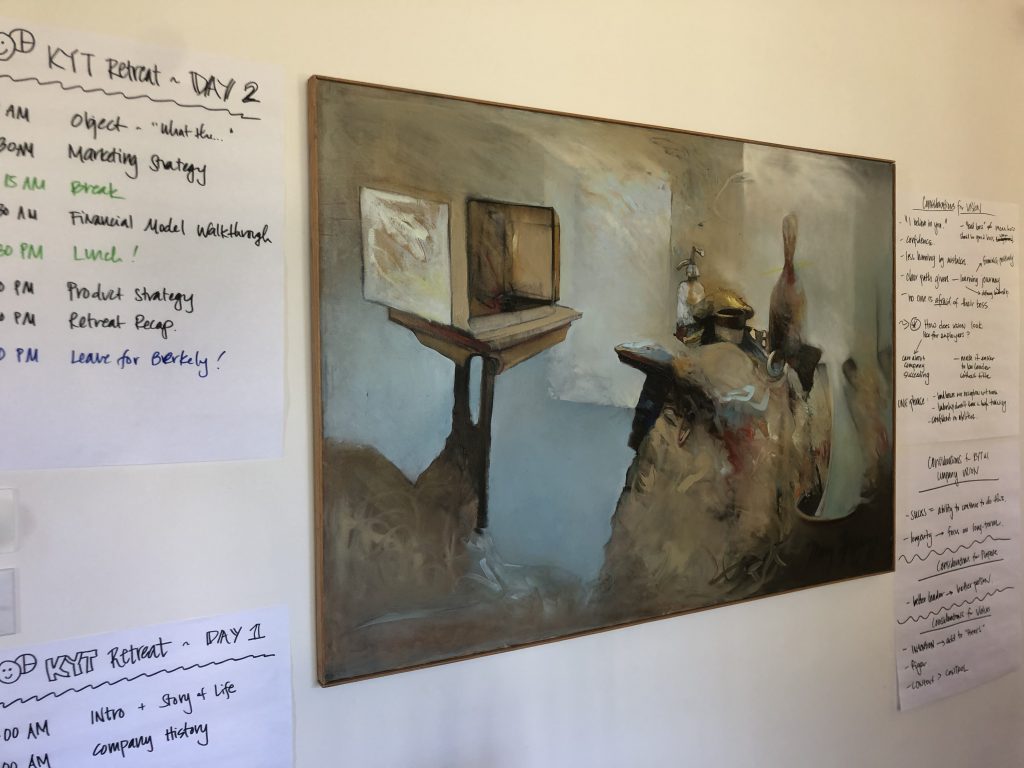
Defining success together at the beginning of the retreat was one way to help create alignment. However, the most critical form of alignment needed to happen around the organization itself. A retreat is a rare opportunity for everyone to get on the same page about where the company is headed, and why. As stated in a 2011 article published by McKinsey & Company: “One study found, for example, that when people understand and are excited about the direction their company is taking, the company’s earnings margin is twice as likely to be above the median.”
Here are the areas we covered to ensure stronger alignment between each team member to the organization, each team member to the strategy, and each team member to one another:
- Company vision. Company vision is the single most motivating factor for an employee – and greatest source of clarifying decisions. So getting on the same page about this was crucial. With Know Your Team, we did an exercise where we gave feedback to the current company vision statement and brainstormed ways to make it better. We did the same thing for the company mission statement and company values.
- Personal vision. An organization can’t be aligned unless it’s supporting the individual visions of the people themselves. As a result, I asked our team to do a little homework assignment prior to the retreat: To respond to the prompt, “What would you like to be true 10 years from now for your life to feel meaningful?” The response could be anything – a drawing, a sentence, a manifesto – whatever they wanted to be, and you couldn’t spend more than an hour on it. I was blown away by the responses: They were thoughtful, introspective, energizing, and ambitious. After sharing each of our answers with one another, we then discussed how Know Your Team could better support our own personal visions.
- Company strategy. Daniel and I shared both our product strategy and marketing strategy for the next 6 – 12 months, as well as the frameworks for how we think about both. We dove into the numbers of where we are today, and what we need to do to get to where we want to be. We also included brainstorming sessions to answers to prompts, such as “What can we do to delight customers even more?”
#4: Build trust.
Fostering trust and social connection in a remote team is notoriously difficult. When you don’t see everyone face-to-face regularly, the opportunities for bonding over shared interests or moments of hilarity naturally reduce. In our to a survey we ran this past fall with 297 remote managers and employees, “fostering a sense of connection without a shared location” was seen as the #1 most difficult part of being a remote manager – and the #1 most difficult part of working remotely, in general.
But remote companies are not the only companies that struggle with encouraging a sense of connection in the workplace: CNN recently reported how “even in open-plan office spaces with little separation, workers can feel disconnected from their colleagues. Coworkers sitting around the same conference table or in daily meetings together can have no real relationship.”
As a result, a successful team retreat should be a time for team-building and establishing trust, as much as it is for aligning the team and sharing context.
For the Know Your Team retreat, here’s exactly what we did to build trust and rapport:

- “Story of Life”. A CEO in Chicago who is a good friend of mine shared with me one of his favorite ice breaker activities called, “Story of Life.” Each person draws two axes: The vertical one is “Happiness” and the horizontal one is “Time.” You can then plot your life’s moments, starting with your birth to the current day. Then, everyone else asks about particular moments on a person’s plotted line. The result, for our team at least, was incredibly vulnerable, raw sharing of our lives – the low points, high points, and everything in between.
- “What is that?” I asked everyone on the team to bring one object with them – anything that might have a story. It could be funny, trivial, symbolic or just plain weird. This was a wonderful way to learn about people’s hobbies, interests, and unique backgrounds. For instance, one person brought their BMX biking glove, and another person shared their tattoos as their “object”.
- Cooking meals together, attending a concert, kayaking, hiking. We carved out a good amount of time during the retreat also just to have fun. We cooked meals together, went out to delicious dinners, saw a concert one night, and spent a day hiking and kayaking near Point Reyes, California.
- Share why certain people left the company. Part of building trust isn’t just getting to know each other as people – but also getting to know the company better. I made it a point to share what other leaders might consider more “intimate” details of the company’s history. For instance, I shared exactly why each person in the past had left our company – along with not just our highlights as a company, but the lowlights too.
- Walked through financial models together. As a way to be transparent about the company and instill greater trust in the organization, I also walked through our company’s financial model. This way, each team member could understand the inputs to the business (e.g., revenue, expenses, taxes), and what various financial scenarios for the company would look like, depending on how the company performed.
What this looks like in practice
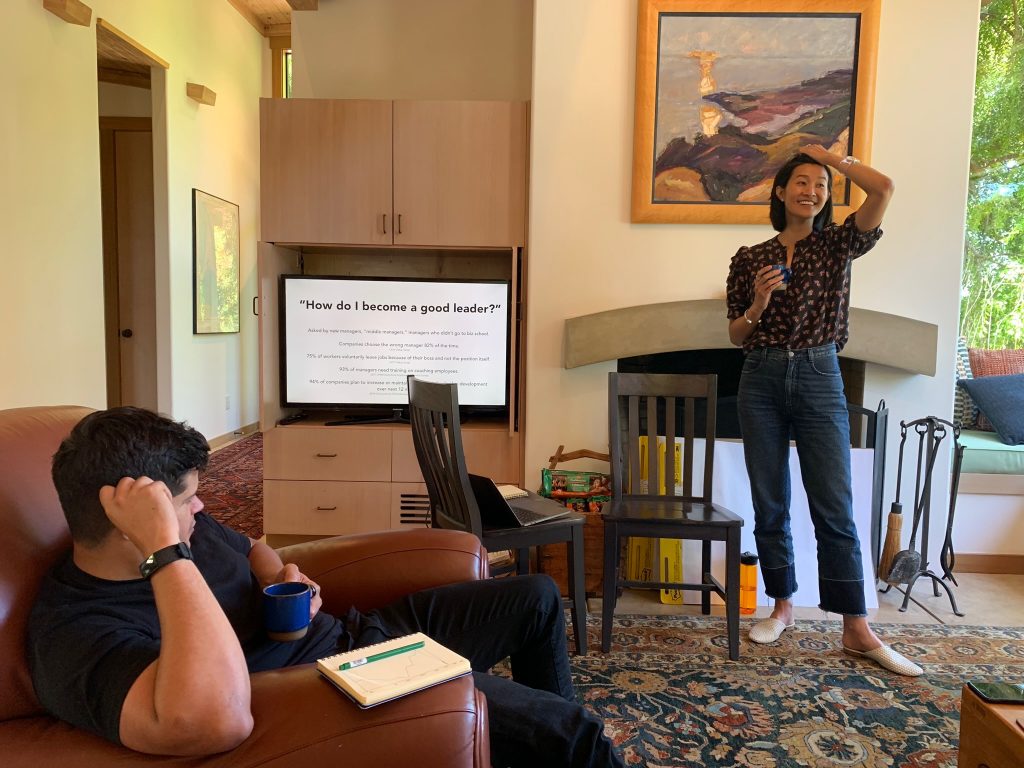
Based on the conversations in our online leadership community, most companies host some sort of yearly or a few-times-a-year meet-up. Other companies do week-long retreats three times per year.
For remote companies in particular, according to our survey, we found that the most common frequency of meeting in-person was “several times a year” (25% said this) and that they spend on average $1,001 – $5,000 per employee (29% of respondents said this) to accomplish this. Some hold these retreats at the company headquarters. Others fly everyone out to a separate location.
For us at Know Your Team, we held our team retreat over three days, renting out an Airbnb in Point Reyes, California (an absolutely stunning part of the country, if you’ve never been!).
Here’s an actual look at the exact retreat agenda that I shared with our team beforehand, so you can get a sense of how we incorporated sharing context, aligning the team, and fostering trust…
Day 1
- 9:00am – 9:15am: What does success look like for this retreat?
- 9:15am – 10:15am: Story of Life. We’ll do a fun little welcoming activity that shares about the story of your life 🙂 Everyone will get 10 minutes each.
- 10:15am – 11:15am – Company history trivia. As a way to get on the same page about the company history + learnings, we’ll do a little interactive trivia game hehe.
- 11:15am – 11:45am: Break.
- 11:45am – 12:30pm: Market opportunity and competitive landscape. What the market looks like, who the players are. Why we’re uniquely equipped for this opportunity.
- 12:30pm – 2:00pm: Lunch / break.
- 2:00pm – 3:15pm: Diving deep into the problem. Our customers’ pain, the problem + understanding it intimately.
- 3:15pm – 3:30pm – Break.
- 3:30pm – 4:30pm: Company vision, mission, values. What’s our picture of a better place 1 year from now? 4 years from now? 10 years from now? In how we serve customers? In who / how we are as a company internally? Who are we? Who are we not? Why? What are our values? How do we choose who to hire?
- 4:30pm – 5:30pm: Personal visions. Prior to the retreat, I’ll ask everyone to write up a doc on their personal visions for themselves in the future. We’ll then take time to share during this time. I’ll share this exercise document shortly. We’ll riff on how KYT can support those visions.
- 6pm: Dinner.
Day 2
- 9:00am – 9:45pm: “What is that?” I’d like to ask everyone to bring an object, and over lunch, we’ll share it with the team. The object literally could be anything… weird, funny, trivial, meaningful, symbolic, whatever. It just needs to have a story and something to answer the question, “What is that?”
- 9:45am – 10:45am: Marketing Strategy. What is our marketing strategy? Unique value proposition? How has our marketing evolved over time? What’s worked, what hasn’t worked? We’ll also discuss our strategy/plan for the next 6 – 12 months, and our vision for the next 1 – 2 years.
- 10:45am – 11:00am: Break
- 11:00am – 12:00pm: Financial model walkthrough. We’ll walk through our financial model + assumptions
- 12:00pm – 2:30pm: Lunch / break.
- 2:30pm – 4:00pm: Product Strategy. How has our product + has evolved over time? What’s worked, what hasn’t worked? Usage analysis of each feature. Our strategy/plan for the next 6 months, and our vision for the next 1 year.
- 4:00pm – 4:15pm: Recap of retreat
- 5:45pm: Dinner + concert
Day 3
- 11am: Kayaking + hiking!
- 7:30pm: Dinner.
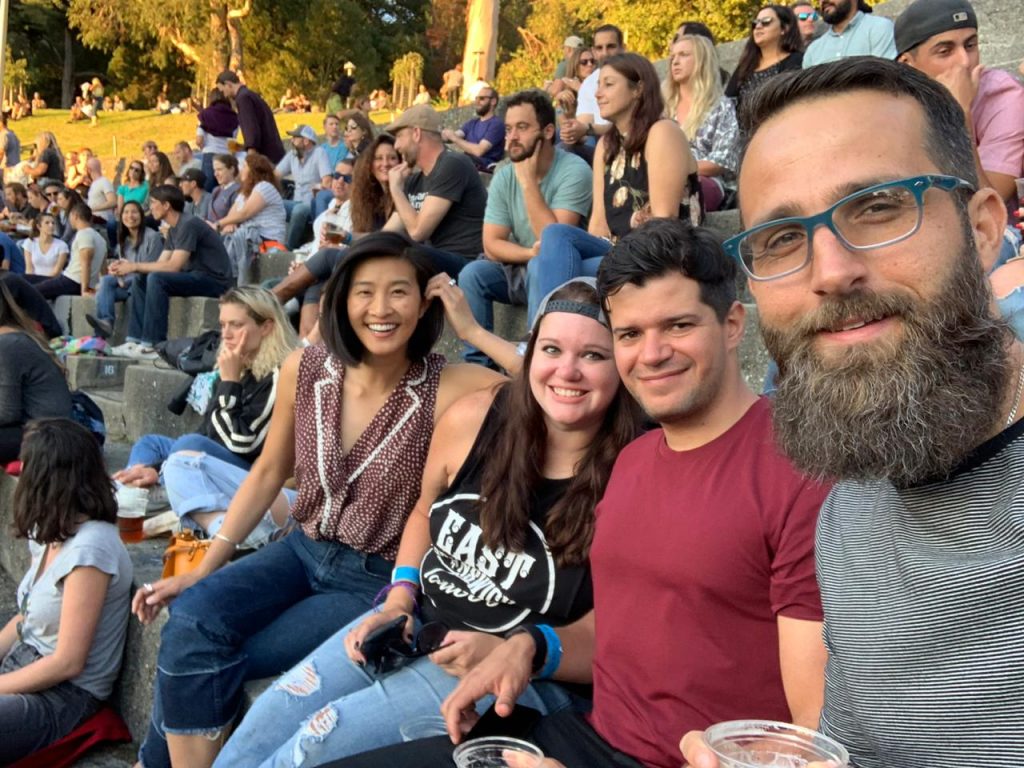
After this retreat, “I’m leaving incredibly motivated” and “I now know exactly what we need to do” and “I’m so grateful for this team” were the most common sentiments verbalized by folks. I was floored by how strong and heartfelt the reactions were.
That being said, every company and team is at a different point in time in their life cycle – these aspects of a retreat I shared here might be more salient for some teams rather than others. For us, as a newly formed team that recently grew, these elements of trust, context, and alignment were most critical for us.
Regardless of what you choose to include in your own team retreat, I hope you can bring a purposeful approach. That, in itself, is what will make yours most successful.

